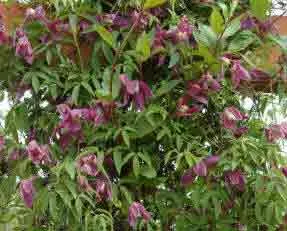Group 1.
This group of Clematis are the very early flowering
types - such as Clematis Montana, and the evergreen Clematis armandii.
These all flower on growths made in the previous year. (They all flower
before making growth in the current year, as growth does not start until well into the spring season.) They need a full growing season to make flower buds for the following year, so if you prune this type of
Clematis too late in the year - say mid-summer - they do not have enough time in the latter part of the year to make flower buds. So the
following year there will be no flower.
Clematis alpina Constance - Flowers in April - on growth
made the previous year.

Image © David Hughes
It is important to remember with these Clematis varieties that of they are to be pruned, then it must be right after flowering. If they are pruned back too late in the year, then they will not have time to make the flower buds ready for the following spring. Pruning normally takes the form of 'tidying' the plant, or bringing it back under control perhaps.
It is as well to have a good look at these varieties of Clematis at
flowering time, to try to visualise what amount of growth they will put
on during the coming summer growing season. If you feel that it is going to need cutting back sometime in the year, then best to do it early and not leave it too late in the year.
Late pruning will not harm these Clematis -simply delay the flowering, so that you will maybe not get any flowers for two years!
Hard Pruning to Rejuvenate
This group of Clematis can be pruned - cut back - hard if desired, in order to rejuvenate it, or to get rid of older woody stems. They will soon re-sprout into growth, and the worse that will happen is that you may just not have quite as many flowers the following year. However, the year after that they will flower as normal.



